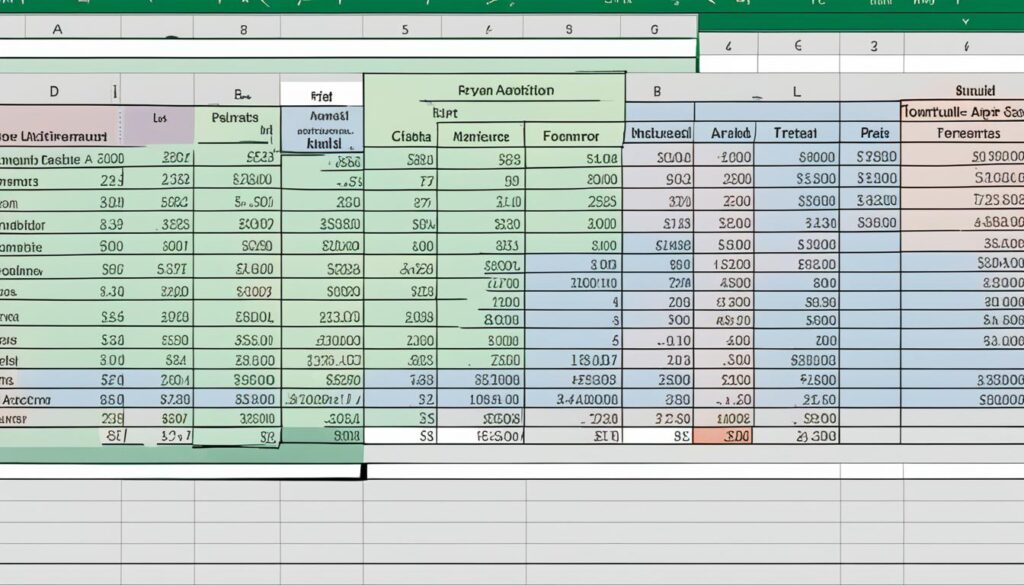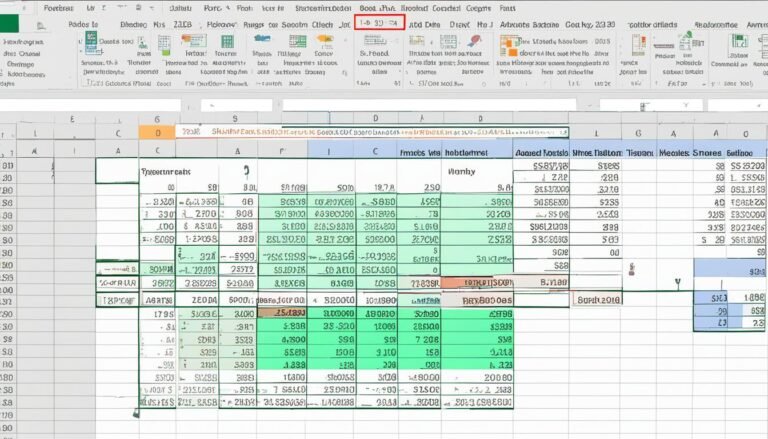Easily Create an Amortization Schedule in Excel
As an MS Excel expert with over 12 years of experience, I help teach Excel to many. People often ask me about making an amortization schedule in excel. An amortization schedule is super important for tracking loan payments. It shows each payment’s principal and interest, making it clear how much is left after each payment.
Making an amortization schedule in Excel gives you a good look at your loan’s progress. This helps with planning your finances and making a solid debt repayment plan.
Key Takeaways
- An amortization schedule provides a detailed breakdown of periodic loan payments into principal and interest portions.
- Creating an amortization schedule in Excel allows for better financial planning and loan payoff schedule tracking.
- Excel’s built-in functions, such as PMT, IPMT, and PPMT, simplify the process of generating an installment plan calculator.
- An amortization schedule offers transparency into the loan’s progression, enabling informed decision-making.
- By creating an amortization schedule in Excel, you can effectively manage debt and optimize your finance spreadsheet for personal or business purposes.
What is an Amortization Schedule?
Many people ask me about making amortization schedules in Excel. An amortization schedule shows each periodic loan payment’s principal and interest parts. It also highlights the remaining balance after each payment.
Definition of an Amortizing Loan
An amortizing loan is a loan paid off in parts over its life. It includes both the principal amount and the interest.
Imagine a 24-month loan. You will make 24 equal payments. Each payment reduces the interest and the amount you borrowed.
Components of an Amortization Schedule
An amortization schedule has many important parts, like:
- Payment period number
- Beginning balance
- Scheduled payment amount
- Interest paid
- Principal paid
- Remaining balance after each payment
This setup shows where each payment goes: cutting down on interest or the loan’s amount. It helps plan for loan repayment schedules and debt repayment plans.
How to Create a Loan Amortization Schedule in Excel
Creating an amortization schedule in Excel is easy and helpful. It gives important info about paying back your loan. Follow these steps to make a loan amortization calculator for your loan.
Set Up the Amortization Table
Start by setting up cells for the loan’s details like interest rate and term. Label columns in Excel for Period, Payment, Interest, Principal, and Balance. Fill in the Period column with numbers up to your total payments.
Calculate Total Payment Amount (PMT Formula)
The pmt formula excel finds how much you need to pay each period. It uses the loan’s interest, how often you make payments, and the loan amount. Adjust the formula for loans with different payment times.
Calculate Interest (IPMT Formula)
To figure out how much of your payment is interest, use Excel’s ipmt function excel. It looks at the interest rate and your current payment number. The interest part of your payment lowers over time as you pay off more of the loan.
Find Principal (PPMT Formula)
To see how much goes to lowering your loan amount, use the PPMT function in Excel. It looks at the same things as IPMT but shows the principal amount. As you keep making payments, the part that goes to the principal amount gets bigger.
Get the Remaining Balance
To know how much you still owe after each payment, use two formulas. For the first payment, add the loan amount to the principal paid. For later payments, add the previous balance to the current principal paid. This keeps track of your loan’s balance as you pay it off.
By doing this, you’ll have an amortization schedule in Excel. It helps you manage your debt repayment plan well. You’ll see how your loan gets paid off over time. This tool is great for making smart money choices and watching your loan get smaller.
Return Payments as Positive Numbers
In Excel, when you make a loan amortization schedule, payments and loan parts show as negatives. They’re in red and have parentheses. This fits with accounting but can be confusing at first look.
To make these values positive, you can add a minus sign. Just use =- before the PMT function. This turns payments into positive numbers. Now, your amortization schedule is clearer and easier to understand.
Changing payments to positive numbers improves how your schedule looks. It’s easier to see and follow your payment plan. This makes tracking your progress less confusing.
As an Excel expert, I highly recommend adjusting your amortization schedule formulas to display positive numbers. It’s a simple change that goes a long way in making your loan payoff schedule more intuitive and user-friendly.
Amortization Schedule for a Variable Number of Periods
Creating an amortization schedule that’s flexible is key for dealing with loans of different lengths. It lets you work with loans of any duration while keeping things easy to manage. This way, you’re ready for loans with a maximum loan periods excel, no matter the length.
Input the Maximum Number of Periods
First, decide on the length of your loan by picking a number for the maximum loan periods excel. For example, you could choose to have up to 30 years of payments. You’d set it from 1 to 360 years. Using Excel’s AutoFill makes this step quick and saves time.
Use IF Statements in Amortization Formulas
Next, with all possible payment periods in the schedule, you need to limit calculations to the real payment amounts. You do this by using if statement amortization formulas. These check if a payment is needed for each period. If it is, the formula works. If not, it shows as blank, handling conditional amortization calculations.
Hide Extra Period Numbers
Once the loan is settled, you might want to hide unused periods excel to keep your table neat. You can set up a conditional formatting amortization schedule. This feature makes cells with extra payment periods after the loan ends appear white, cleaning up your view.
Make a Loan Summary
To quickly see your loan’s key financial numbers, add a few more formulas to the top of your table. The SUM function helps calculate the total payments and interest by adding up the Payment and Interest columns. This creates a loan summary excel section for an easy overview of the loan’s full cost and final payment value.
Create Amortization Schedule with Extra Payments
Want to pay off your loan faster by making additional principal payments? Doing this leads to an accelerated loan payoff. It can help you save a lot on interest over your loan’s life. This guide will show you how to make an amortization schedule that includes these extra payments.
Define Input Cells
First, let’s set up the important input cells amortization schedule in Excel. You should input loan details like interest rate, loan term, and how often you’ll make payments. Also, add a cell for the extra payment amount each time. Name these cells clearly, like “InterestRate” and “ExtraPayment.” This makes your amortization inputs clear and easy to change.
Calculate a Scheduled Payment
Next, figure out the scheduled loan payment without any extra payments. This is the amount you owe at each payment, plus interest. Use an IFERROR formula around the PMT function. It makes sure it’s clear if there’s an error. The PMT function finds the base payment amount based on your loan’s info.
Now that you know your scheduled payment, you can add the extra payments. The total payment for each period is the regular payment plus any extra amount. This method lets you see the accelerated loan payoff and how much you’ll save thanks to your extra payments.
Alternative Method to Create Amortization Schedule
Let me share an alternative amortization method in Excel. This method uses the PMT, PPMT, and IPMT functions to create a loan amortization schedule. We will calculate the monthly payment and the parts that pay off the loan and the interest.
First, set up the input cells. Add cells for the loan amount, interest rate, and term. You can name them something like “LoanAmount,” “InterestRate,” and “LoanTerm.”

Next, calculate the monthly payment with the PMT function. Use this formula in a new cell:
=PMT(InterestRate/12,LoanTerm*12,LoanAmount)
Remember, to get the monthly interest rate, divide the annual rate by 12. To find the number of payments, multiply the years by 12.
| Period | Payment | Interest | Principal | Balance |
|---|---|---|---|---|
| 1 | =PMT(InterestRate/12,LoanTerm*12,LoanAmount) | =IPMT(InterestRate/12,1,LoanTerm*12,LoanAmount) | =PPMT(InterestRate/12,1,LoanTerm*12,LoanAmount) | =LoanAmount-PPMT(InterestRate/12,1,LoanTerm*12,LoanAmount) |
| 2 | =PMT(InterestRate/12,LoanTerm*12,LoanAmount) | =IPMT(InterestRate/12,2,LoanTerm*12,Balance1) | =PPMT(InterestRate/12,2,LoanTerm*12,Balance1) | =Balance1-PPMT(InterestRate/12,2,LoanTerm*12,Balance1) |
To fill the schedule, make a table with columns for Period, Payment, Interest, Principal, and Balance. In the first row, use the formulas above. We update the balance each time using the IPMT and PPMT functions.
For the next rows, just copy the formulas and adjust the period number. Also, use the previous row’s balance in the IPMT and PPMT functions.
This alternative amortization method in Excel looks at each payment’s details. It keeps track of the loan balance as we go.
Using a Template for Loan Amortization Schedule
I’m an Excel expert with over 12 years of experience. I always recommend using a loan amortization template excel to save time. You can get a pre-built amortization schedule template for free from Microsoft Office. This makes it super simple to figure out your total interest and payments for a loan.
The great thing about this amortization schedule template download is it lets you add extra payments. Just type in how much extra you want to pay each period. The template updates the schedule to show how this affects paying off your loan faster.
Including extra payments in the template simplifies making a complete amortization plan. It lets you test different repayment methods and maybe lower your interest costs.
Managing mortgage or personal debt? A loan amortization template excel will make it easier. It helps track your loan’s progress and supports smart financial choices.
- Save time by avoiding the need to build the schedule from scratch
- Ensure accurate calculations with pre-built formulas
- Easily adjust inputs to reflect your specific loan terms
- Explore the impact of extra payments on interest savings
A well-made amortization schedule template download benefits both pros and beginners. It is key for handling loan payments well.
Changing Amortization Schedule for Different Pay Periods
After twelve years as an MS Excel expert, I find Excel’s flexibility amazing. We can easily adjust amortization schedules for different pay periods. Even though we have looked at monthly payments, it’s simple to change formulas for weekly or quarterly amortization payments.
For weekly amortization schedules, you just tweak the formulas. Update the PMT formula to use a weekly calculation. You divide the interest rate by 52 instead of 12. This tweak makes the interest calculations match the weekly payment setup.
Remember, when adjusting pay period amortization, it’s crucial to update not only the PMT function but also any other formulas that rely on the number of payment periods per year.
Creating an amortization schedule for quarterly amortization payments involves a simple change. You just replace the “12” with a “4” in the interest formulas. This adjustment fits the four times payments are made in a year.
Excel’s feature to adjust pay period amortization is really helpful. It lets you customize amortization schedules to your loan’s terms. Whether payments are weekly, monthly, quarterly, or yearly. This customization makes sure your amortization schedule matches how you’re paying off your loan.
Mastering Loan Management with Excel’s Amortization Schedule
After more than 12 years using Excel, I know how valuable it is for managing loans. An amortization schedule in Excel can help you track loan payoff. It separates each payment into parts for the principal and the interest. This way, you can clearly see how much is left to pay off. You get to understand your loan’s progress better this way.
You can start from scratch or use Excel’s ready templates to make a schedule. Its tools are perfect for making a detailed plan that fits your loan and how often you pay. It can even include if you want to pay more of the principal. Loan management excel makes paying your loan off faster a lot easier.
This solution offers a clear way to pay off your debt and helps you learn more about your money. By keeping an eye on your loan’s schedule, you can pick the best strategies. This can help you reach financial freedom faster. Using Excel’s amortization schedule can really turn the tide in your favor. It’s all about starting on a path to track loan payoff victory.
FAQ
What is an amortization schedule?
An amortization schedule is a table that shows how each loan payment is split. It details the part that goes to the principal and what goes to interest. This table helps keep track of your loan payment progress.
What is an amortizing loan?
An amortizing loan gets paid back through fixed installments over its life. This means, all loans work this way. They need regular payments that chip away at both the borrowed amount and interest.
What are the key components of an amortization schedule?
It includes the loan payment number, the starting balance, how much you have to pay, interest, the principal amount, and what’s left to pay after. Each of these is a critical part of the schedule.
How do I set up an amortization table in Excel?
First, you input the loan’s specifics (like interest rate and the amount). Then, in Excel, name the columns for Period, Payment, Interest, Principal, and Balance. Fill them based on formulas and your loan info.
How do I calculate the total payment amount in Excel?
Use Excel’s PMT function to find your regular payment. It adjusts for various payment timings by changing the interest rate and the number of payment periods.
How do I calculate the interest portion of each payment in Excel?
For the interest part of payments, use Excel’s IPMT function. It needs the loan’s rate, current payment period, total payments, and loan amount to work out the interest payment.
How do I find the principal portion of each payment in Excel?
To calculate the principal amount in every payment, turn to Excel’s PPMT function. It uses the same details as the IPMT but shows how much of each payment goes to reduce the loan amount.
How do I display payments as positive numbers in Excel?
Excel may show payments as negatives. Fix it by putting a minus (-) sign before your PMT, IPMT, or PPMT functions. This flips them to positives.
How do I create an amortization schedule for a variable number of periods in Excel?
First, set the maximum period. Then, use IF statements in your formulas. This helps to only calculate up to the number of actual payments. Lastly, use conditional formatting to hide extra periods once the loan is done.
How do I create an amortization schedule with extra payments in Excel?
Start by adding cells for extra payments along with your loan details. Calculate the regular payment first. Then, add the extra payment to find your new total for each period.
Are there any pre-built templates for creating a loan amortization schedule in Excel?
Yes, you can download a loan amortization schedule template from Microsoft Office for free. It helps calculate interest and payments and adds any extra payments you might make.
How do I adjust the amortization schedule for different pay periods in Excel?
For weekly payments, update the PMT formula to use an interest rate divided by 52. For payments every three months, change the “12” in the formulas to “4”.





